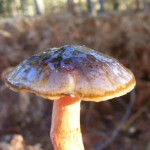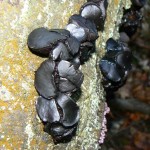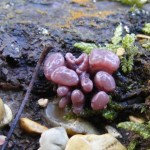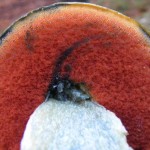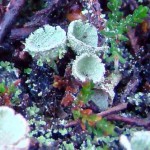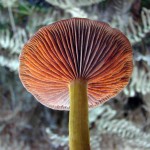Autumn colours were much in evidence for the walk at Wokefield Common and Starvale Woods, between Burghfield Common and Mortimer, on Sunday 11th November. The beeches, larches and sweet chestnuts were a glorious mixture of yellows, oranges and gold but the leaves on the oaks, hazels and alders were still predominantly green. The field trip was a joint enterprise between Jan Haseler, who navigated, and Gordon Crutchfield, who identified the fungi. The walk started from the pine plantation next to the pond at Wokefield Common. Around the car park were rings of Clouded Agaric and many Common Earth-balls. At the base of a pine tree were several specimens of Cow Boletus Suillus bovinus which were orangeish pink and sticky on top, with a complicated sub-cell structure on the pores on the underside. Some fungi are best identified by taste. Gordon invited volunteers to test (and then spit out) small bits of The Sickener Russula emetica, which was initially bland, but then gave a fiery chilli sensation on the tongue. A second species, Russula sardonia, was so unpleasant that all Gordon’s subsequent tasting suggestions were politely declined. Fortunately, a tube of strong peppermints was produced to remove the after-taste. Small pale-yellow gelatinous spoon-shaped fungi growing out of a dead pine twig were identified as Pale Stagshorn Calocera pallidospathulata. This was first discovered in Yorkshire in the 1980s and has subsequently been widely recorded across the country. Other species in the pine plantation included Common Yellow Russula Russula ochroleuca, Bay Boletus Boletus badius, False Death Cap Amanita citrina and the slimy olive-brown wax cap Herald of Winter Hygrophorus hypothejus.
The route then led southwards across a steep valley into Starvale Woods. Back in the summer, White Admiral, Silver-washed Fritillary, Comma and Peacock butterflies had all been seen on sunny bramble blossom a little further down the valley. At the side of the wide grassy ride were Wood Spurge and Wood Sage, and Herb Robert and Creeping Buttercup were still in flower. The next track led through a Sweet Chestnut plantation to a row of magnificent old beech trees. On a fallen beech trunk were the flattened lumps of Black Bulgar Bulgaria inquinans and the lines of small pale purple jelly-like lumps of Ascocoryne sarcoides. One of the standing trees had a curving column of shiny white Porcelain Fungus and grey Oyster Mushrooms. Growing out of the bank below the beeches was a single specimen of Boletus luridus. The pores underneath were bright red with a yellow rim. Gordon split open the cream-coloured stem and it immediately began to stain a dark blue-green. Several specimens of the slimy greyish brown Beech Milkcap Lactarius blennius were found amongst the fallen leaves.
The next stage of the walk was the open heathland across the road. The invasive American rush Juncus tenuis was growing on the tracks. Both Gorse and Dwarf Gorse were seen – the latter had noticeably smaller prickles. Most of the heath was covered by a blanket of heather, but the Pixie Cup Lichen Cladonia pyxidata was spotted in some of the gaps. Re-crossing the road, the route then led through another pine plantation. Finds here included the False Chanterelle, Collybia maculata and Cortinarius semisanguineus. The next footpath went through hazel coppice and for the first time there were signs of a rich herb layer, with leaves of violets, Wood-sorrel, Sanicle, Bugle and Wood Spurge. The path dropped down through the wood, then ran alongside a small stream. Ferns were growing on its steep shady banks, including Broad Buckler Fern, Male Fern and Hart’s-tongue. At the edge of the wood was a small flowery meadow, with Betony, Devil’s-bit Scabious and Marsh Thistle. The light was beginning to fade during the return walk to the car park.
Pictures by Rob Stallard, Chris Ash and Laurie Haseler
Fungi:
| Suillus bovinus | Cow Boletus |
| Tremella mesenterica | Yellow Brain Fungus |
| Boletus badius | Bay Boletus |
| Calocera viscosa | Yellow Stagshorn |
| Russula emetica | The Sickener |
| Russula sardonia | Primrose Brittlegill |
| Laccaria laccata | Deceiver |
| Paxillus involutus | Brown Rollrim |
| Collybia butyracea | Butter Cap |
| Calocera pallidospathulata | Pale Stagshorn |
| Baeospora myosura | Conifercone Cap |
| Mycena galopus | Milking Bonnet |
| Cortinarius semisanguineus | Surprise Webcap |
| Stereum hirsutum | Hairy Curtain Crust |
| Russula ochroleuca | Common Yellow Russula |
| Hygrophorus hypothejus | Herald of Winter |
| Gymnopilus penetrans | Common Rustgill |
| Amanita citrina | False Deathcap |
| Scleroderma citrinum | Common Earth-ball |
| Boletus cisalpinus | |
| Hypoxylon multiforme | Birch Woodwart |
| Amanita muscaria | Fly Agaric |
| Lactarius blennius | Beech Milkcap |
| Auricularia auricula-judae | Jelly Ear |
| Russula nobilis | Beechwood Sickener |
| Bulgaria inquinans | Black Bulgar |
| Ascocoryne sarcoides | Purple Jellydisc |
| Xylaria hypoxylon | Candlesnuff Fungus |
| Pleurotus ostreatus | Oyster Mushroom |
| Oudemansiella mucida | Porcelain Fungus |
| Boletus luridus | Lurid Bolete |
| Hypoxylon fragiforme | Beech Woodwart |
| Tephrocybe rancida | Rancid Greyling |
| Clitocybe nebularis | Clouded Agaric |
| Crepidotus variabilis | Variable Oysterling |
| Exidia thuretiana | White Brain |
| Hygrophoropsis aurantiaca | False Chanterelle |
| Collybia maculata | Spotted Toughshank |
| Hypholoma fasciculare | Sulphur Tuft |
| Mycena pelianthina | Blackedge Bonnet |
| Cystoderma amianthinum | Earthy Powdercap |
| Mycena inclinata | Clustered Bonnet |
| Peniophora quercina |
Plants:
| Euphorbia amygdaloides | Wood Spurge |
| Teucrium scorodonia | Wood Sage |
| Ulex minor | Dwarf Gorse |
| Oxalis acetosella | Wood-sorrel |
| Ajuga reptans | Bugle |
| Sanicula europaea | Sanicle |
| Phyllitis scolopendrium | Hartstongue Fern |
| Dryopteris dilatata | Broad Buckler Fern |
| Succisa pratensis | Devil’s-bit Scabious |
| Stachys officinalis | Betony |
| Cladonia pyxidata | Pixie Cup Lichen |

